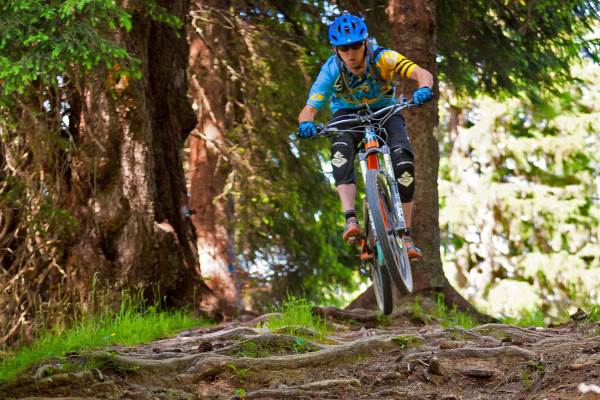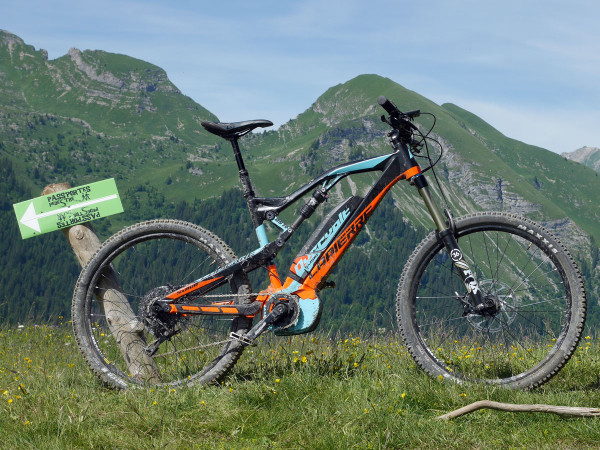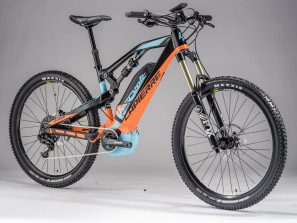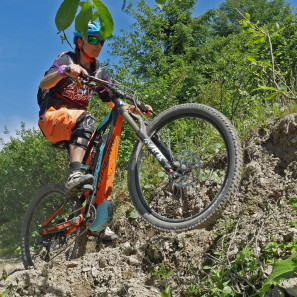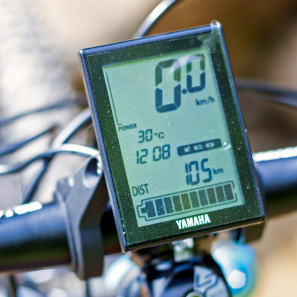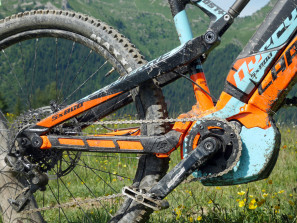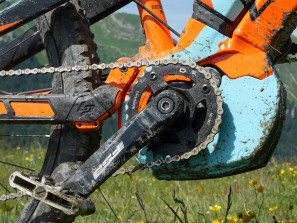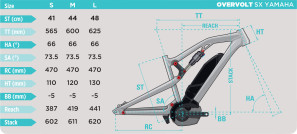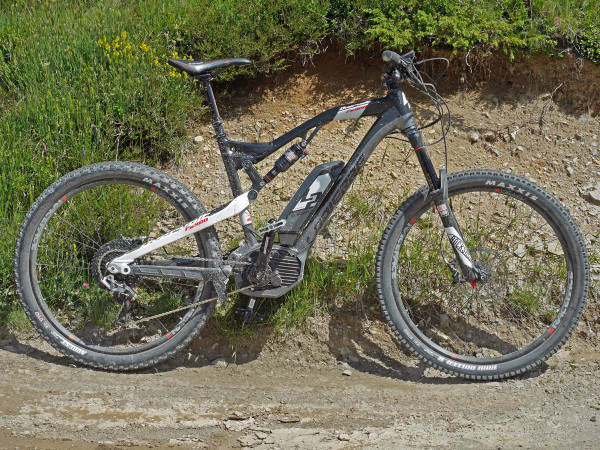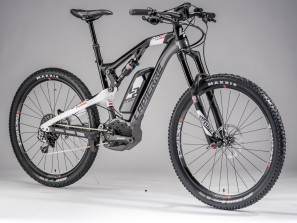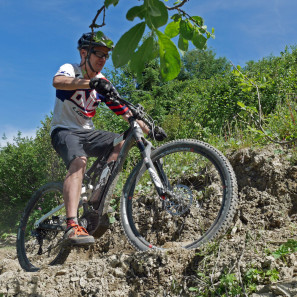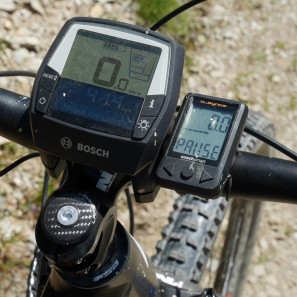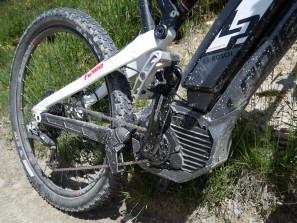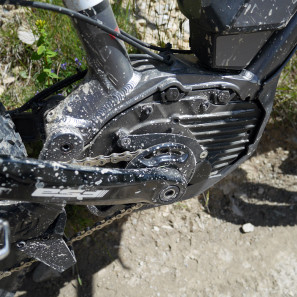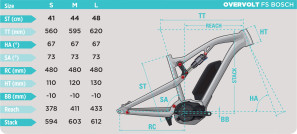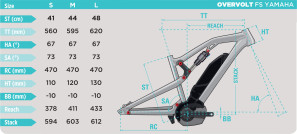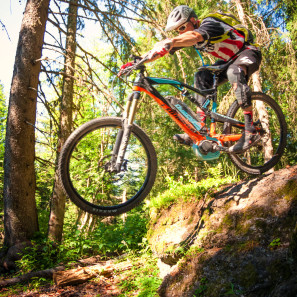To add to the reworking of their popular Zesty line, Lapierre also put a lot of effort going in a completely other direction. As one of the very few companies seriously developing off-road e-bikes, Lapierre has gone all in with an expansion of their Overvolt range of bikes. With three distinct mountain lines – SX (Super Cross), FS (Full Suspension), and HT (Hard Tail) – there is pretty much an option for whoever thinks this is going to be a good idea. Now, let’s get it out up front that we are not so sure about the e-MTB concept, and have some real serious reservations about letting these loose in the world. But there is no denying that this is a real direction that the industry is headed, so I’ve jumped in head first myself to give our readers a deeper look of what’s going on. (And I know I’ll get flak for this write-up, but it needs to be heard.)
We spent a good bit of time on the two new 27.5” Overvolt full suspension options, with drive motors from Yamaha and Bosch, on an incredibly wide range of technical trail and otherwise unrideable terrain. After all of that, it’s safe to say that I’m not selling a single one of my bikes to try to fund an e-MTB, but I can say I have a better understanding of them, their potential application and pitfalls, and have some thoughts as where e-bikes are headed. Stay with me, and I’ll give you the full details on the “bikes” and my thoughts…
Overvolt SX Yamaha
We’ll start with the playful Overvolt SX, which is a 170mm travel bike powered by a Yamaha motor. The motor is new to Lapierre this year, but has basically the same specs as the Bosch they also use on the FS. Both bike lines focus less on weight – since motor and battery already add so much – and go more for durability. Adding and extra 250W of power to your pedal stroke is hard on drivetrains, as is bombing down techy trails on such a heavy machine.
The pedal assist function of e-bikes also has a lag between when power is put to the pedal and when it comes back from the motor. This makes it a bit tougher to ride the bikes on technical terrain, and you really need an adjustment period to get in sync with a new bike. Once mastered, the motor does wonders in getting up steep step-ups and off ledges, but until that point it is just waiting to buck you off riding drops or to ram you straight into the lip of a jump. The SX seemed to suffer a bit less from lag, and with a slightly higher/more rearward weight balance was easier to get in the air or to manual.
The bikes really are intended to hit the trails hard. So they all come spec’d with e-bike-specific chains (I still broke a link in a KMC chain during my second ride on a steep climb), heavy duty wheels and reinforced casing tires, big rotors, and guides on the chainstays. Like the Zestys, the 2016 Overvolts all get updated OST+ geometry for a stable and aggressive ride. Lapierre decided not to put their excellent e:i Auto Shock system on the e-MTBs yet, as they are still developing an e-bike optimized software tune for it, and aren’t happy to just slap something together.
The Yamaha system has a few unique touches that set it apart. Its use of an ISIS splined crank interface makes double chainrings a possibility. The Yamaha batteries also get a 2.5hr rapid charger, while the standard recharge time is 4 hours 30 minutes.
The Yamaha motor now adds a fourth, lower energy efficient power assist level to increase ride times: Eco Plus, Eco, Normal, and Speed. The Yamaha system also adds a USB port to charge devices on the fly like a cell phone or GPS off the main battery.
The Overvolt SX Yamaha comes in just one model the 800, and retails for 5000€. It comes in 3 frame sizes.
Overvolt FS Bosch
The Overvolt FS variant is a 140mm bike that carries over from 2015, with updates similar to the Zestys for a longer front end. Its trail demeanor felt a bit more weighted down by the motor and battery, and really preferred to stay firmly planted to the ground. The weight of these bikes and the fact you don’t need to stand up much keeps them planted well into their travel for much of the ride. Add in a slightly lower BB, and this bike suffered a bit from pedal strike. Part of that is the result of riding up obstacles that would otherwise not warrant a second glance, but partially it’s just a newly realized fact that e-bikes deserve shorter cranks.
Like the Yamaha, the Bosch CX is optimized to assist riders pedaling at a constant, relatively low cadence (60-70rpm.) If you get up around 80 or 90rpm, the motor assumes you have everything under control and backs off.
All of the Bosch bikes get the new, more compact CX motor, which was just announced by Bosch two weeks ago. Just like the Yamaha motor, the Bosch CX adds 250W to the rider input. They both also max out at 25 km/h, meaning once you get to that speed it is up to the rider pedaling to maintain it, whether uphill or down. That speed restriction means the motor won’t really help at all on the downhills or jumps, at which point it becomes more of a dead weight/liability.
Lapierre has developed bash guards under the bottom brackets to protect the motors of both sets of bikes. The Bosch bikes also get a custom chainguide that was a bit of work to integrate in the tight space available as well as factoring in the small diameter drive ring (and the fact that the drive ring does not move backwards when freewheeling.) The Bosch CX motor offers four power assist levels: Eco, Touring, Sport, and Turbo, with standard full recharging time is 4 hours 30 minutes.
The Overvolt FS comes in both Bosch and Yamaha versions for 5 overall builds, in 3 frame sizes for each. The Yamaha motor is clearly the more budget solution, although the performance seemed comparable to the Bosch, if not with less of a lag between pedal and assist. The FS900 (5600€) and FS700 (4600€) get the new Bosch CX motor and a 500Wh battery; the FS600 (4300€) gets the new Bosch CX motor and a less long-lasting 400Wh battery; and the FS500 (3800€) and FS400 (3300€) get the new Yamaha motor and a 400Wh battery.
The other bikes in the Overvolt family stick with the Bosch system as far as we know, with the HT retailing for 3000€, while the urban/road e-bikes range from 2500-2800€.
The Overvolts are in production now and should be available from dealers at the end of July. The only exception will be the higher-end Bosch systems that will wait until their bigger 500Wh batteries are available in September.
Final e-MTB Thoughts
So where does it go from here?
Well, I personally can’t see much use to a 140mm e-bike (Sorry Lapierre). Outside of people with limited strength, fitness, or mobility, who might need help pedaling up normal hills, the gains over a comparable 120mm trail bike don’t seem like they really exist. The added weight and subsequent reduced maneuverability of the heavier Overvolt bikes means that they handle terrain like bikes of a bit shorter travel. For the FS that gets you back to a standard trail bike, and doesn’t actually get up the hill much faster. Sure, I was a bit more refreshed at the top of the climbs, but descending was more work, and at the end of 90 minutes pedaling I felt like I’d ridden for an hour and a half. So, a bit of a wash.
From an Enduro perspective, if you don’t have a bunch of lift-served trails to ride, it really isn’t very fun to ride a 170mm bike to the top of a mountain. So it starts to make sense to have a 30kg e-MTB if it is up to punishing descents and ready to help you up all the short steep climbs along the way. Or if you are in one of the unique places like the Portes du Soleil where there are charging stations in the resorts and restaurants, and hundreds of kilometers of accessible trails with tens of linked bike lifts. We had a lot of fun on the Overvolt SX, maybe enough that it embarrassed me a bit. The longer travel bike with its slightly more rearward balance, made it fun (and still work) to throw around on technical descents. And it took some work to keep it going where you wanted it, especially when you try short quick crank inputs to navigate some technical section and the motor wants to offer a lot of help. The SX was happy to be tossed up in the air, and the extra weight gave the impression of stability (less than the sluggishness felt at the shorter travel.) Personally, I still wouldn’t buy one. It just doesn’t have a place in my stable. But if I were in a resort town without a bunch of lifts, but with an excellent trail network, I would have no problem spending a few bucks to rent a bike and get out to explore some trails that I would have otherwise never made it to.
Going forward, one thing not to forget is the provenance of the new Yamaha motor. While Bosch is known for power tools, I’ve had Yamaha dirt bikes ridden around me all of my life. Lapierre says that the choice to go to Yamaha was to offer a bit of variation, even something less common, or to not be locked-in to a single supply chain. But there is no denying the fact that Yamaha knows what is going on riding off-road. Slightly off topic, I’ve seen some pretty impressive electric dirt bikes from the motorcycle manufacturers, and the Overvolt SX isn’t such a far cry away. Sure, Lapierre says that they have no interest in a throttle-powered e-bike, but I can’t be so sure that such a crossover product won’t happen. I guess we should be wary, but not too afraid, as legislation in place in the EU and North America means such a hybrid won’t be classified as a bicycle, but as a motor vehicle. But there is no denying that it is a weird time in the two-wheeled vehicle industries.
As for now, e-bikes are blowing up in the urban sphere where their application makes a lot of sense. And in the heart of the French Alps, there is a mountain bike haven to get your e-bike tires dirty.
